More crap from Joel Kotkin
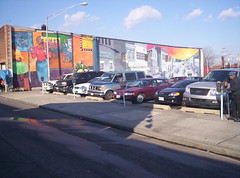 Mural by Northeast Market, Baltimore.
Mural by Northeast Market, Baltimore.Joel Kotkin has an article in The Australian, the "national" newspaper for Australia, about "failures" of the creative class strategy in terms of revitalizing distressed center cities such as Detroit or Cleveland. The article, "For thriving cities, it's not enough to be cool," has an odd and contradictory subtitle, "Dense, arty neighbourhoods have failed to attract talent and capital. What people really want is affordable space."
The article is unfair and facile for a number of reasons:
1. It is impossible for a handful of grubby artists to singlehandedly reverse the global economy and bring back a thriving manufacturing sector to high-wage U.S. communities mentioned such as Detroit, Cleveland, and Pittsburgh.
2. It is deliberatively disingenuous and manipulative to compare thriving center cities such as San Francisco to weak, if not distressed economies such as Detroit with the same analytical brush.
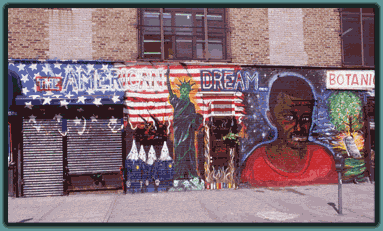 Art contributes, but it isn't the 100% solution in center cities with weak economies, as reflected by these vacant storefronts serving as a canvas for "The American Dream" by Hulbert Waldroup.
Art contributes, but it isn't the 100% solution in center cities with weak economies, as reflected by these vacant storefronts serving as a canvas for "The American Dream" by Hulbert Waldroup.Kotkin writes:
A strong focus on hip culture also hasn't done wonders for a host of less renowned cities, such as Cleveland, Detroit, Baltimore, New Orleans and Newark, which have also continued along their decades-long pattern of deterioration. In all these places, fancy new art museums, rock palaces and overheated loft districts have failed to reverse the flight of jobs and middle-class families.
Building a "creative economy" in a city like Detroit (e.g., Model D (Detroit) Magazine) or Cleveland (Cool Cleveland) has different objectives compared to preserving arts uses in global cities with globally attractive real estate markets, which tends to crowd out all but the most profitable arts uses.
Weak market cities like Detroit and Baltimore utilize the arts to compete not with San Francisco or Manhattan, but with the thriving suburbs in their own metropolitan regions, places like West Bloomfield Michigan or Columbia or Towson Maryland.
Arts districts in places like the Penn Station area (which still has scads of vacant buildings within a block or two of this active railroad station) through the Station North Arts district or the Highlandtown Arts District on Eastern Avenue, both in Baltimore, help these neighborhoods stabilize and develop vis-a-vis other neighborhoods in the city as well as "against" other suburbs in the region.
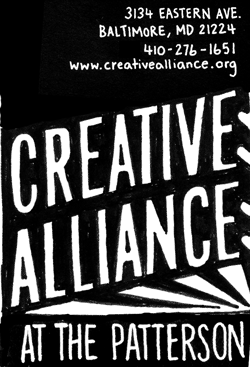
Detroit or Cleveland or Pittsburgh or Baltimore or Newark or St. Louis (etc.) have enough on their plate. Stabilizing population and business leakage, not to mention attracting new businesses and housing, are incremental victories that need to be celebrated.
[I once worked a bit with Ronald Lippitt, one of the founders of the field of organizational development, and one of the big points he and the people who worked with him always made was the necessity of celebrating milestones within an overall project.
Fixing the whole city of Detroit is a goal that would freeze anyone.
But breaking that goal into achievable objectives, such as converting empty buildings into fully-sold/rented loft condominium and apartment buildings. Stabilizing a neighborhood, reopening successfully an old theater, etc., are major wins.]
3. These cities have plenty of affordable space attractive to artists, and it fits right in with Jane Jacobs' thesis about cities needing a "large stock of old buildings" with low rents able to support creativity and innovation.
But the problems of the regional economies are so great that it will take a long time to show the kinds of results enjoyed by the Silicon Valley (anchored by Stanford University) or Seattle (anchored by Microsoft).
Also check out this WKSU Radio (Kent State University) NPR story on rustbelt decline, "Akron and Cleveland are Jumping on the Urban Revival Bandwagon" and this follow up, "Smart Strategies May turn the Trend in Urban Living into a Boom in Downtown Housing."
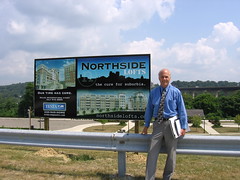 Akron urban planner Jerry Egan stands before a billboard advertising the Northside Lofts in the North Hill neighborhood. From WKSU.ORG.
Akron urban planner Jerry Egan stands before a billboard advertising the Northside Lofts in the North Hill neighborhood. From WKSU.ORG. Note that this is new construction, not adaptive reuse of a once non-residential historic building.
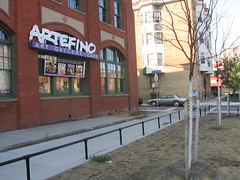 The Artefino gallery and cafe at the Tower Press Lofts at E. 19th and Superior in downtown Cleveland is a gathering place. Most of the residents of the rehabbed building are artists. WKSU.ORG.
The Artefino gallery and cafe at the Tower Press Lofts at E. 19th and Superior in downtown Cleveland is a gathering place. Most of the residents of the rehabbed building are artists. WKSU.ORG. This building Tower Press, is an adaptive reuse project, having been a printing plant for a religious organization. (I visited this building on a tour during the 2002 National Trust for Historic Preservation annual meeting.)
4. The report Artists' Centers: Evolution and Impact on Careers, Neighborhoods and Economies has a different take on this issue compared to Kotkin. From the report:When we published The Artistic Dividend: Urban Artistic Specialization and Economic Development Implications in 2003, calls came from all over the world. Why, people wanted to know, did second-tier metros like Minneapolis–St. Paul, Seattle, Boston, and Portland generate, attract, and retain high concentrations of artists when other fast- as well as slow-growing regions did not? We believe that one important factor is the creation of dedicated centers where artists can learn, network, get and give feedback, exhibit, perform, and share space and equipment. We believe these spaces not only serve artists but contribute to economic and community development in their respective regions.
5. Not only does Kotkin like to bash center cities in favor of sprawl, he works to denigrate the tools and techniques that center cities use to highlight their differences and strengths compared to the typical suburb. Kotkin really should be seen as an advocate for suburbs and sprawl and not as a disinterested "expert" on cities, regardless of his new book The City : A Global History.
6. I haven't read Kotkin's book, so I really can't comment on it, but a reviewer at Amazon makes some good points, which undergird the argument above. From Gaetan Lion:
The present and future of a city most probably depend on a number of variables not well detailed by the author including:
1) Fiscal condition, or does a city has a healthy and growing tax revenue base that can suffice to cover its related cost of delivering public services and running city government?
2) Quality of municipal services including transportation, and most importantly education. For a city to thrive, it needs to deliver very strong secondary and post secondary educational services.
3) An innovative business and cultural environment. Is the city a nest of creativity resulting in a high rate of innovation within commerce, but also the arts, and other domain? Does the city develop other related competitive edges associated with specialized network of professionals? New York benefits a great deal from the huge human capital concentrated in "Wall Street." San Francisco and San Jose benefit greatly from being within close reach of both Silicon Valley and venture capitalists
4) A strategic location. Is the city located at a gateway of domestic or international trading routes? Is it located near a coast, an airport, and a major harbor so it is quickly accessible from around the World?
5) A strategic virtual location. How connected is the city? Does its information infrastructure measure up to other World-class cities?
6) Economic demographics of its residents. What is the educational level and per capita income of its residents? What is the level of homeownership? Business ownership?
7. Creativity is a tool that weak market center cities need to leverage to build upon space and other resources that these cities have in abundance. It's not an easy or simple strategy. Even creative businesses will leave for better circumstances as overall quality of life is a key factor such businesses use to retain employees, and places like Seattle or Boston have significant advantages compared to Pittsburgh or Detroit or St. Louis.
But the point is to use the tools that can work for your situation, not to pine away about the disadvantages. The key is to recognize weaknesses and be honest, and not to try to create attractions that are not likely to work (such as Auto World in Flint, Michigan, which failed after a couple years despite gobs of money from the Mott Foundation).

There is a very good article in yesterday's Wall Street Journal about the failure of GM to think outside of its midwestern base, focusing on Miami and Florida and the failure of its marketing efforts there. But to be honest, it doesn't say anything that John DeLorean didn't say more than 25 years ago. (See "John DeLorean, R.I.P (Rocking Revitalization Part II)".)
Index Keywords: arts-culture; urban-revitalization



0 Comments:
Post a Comment
<< Home